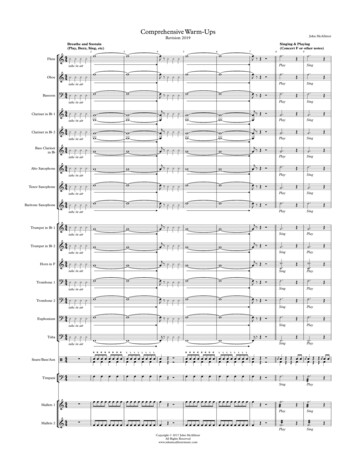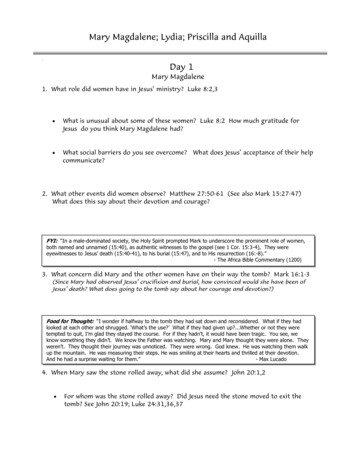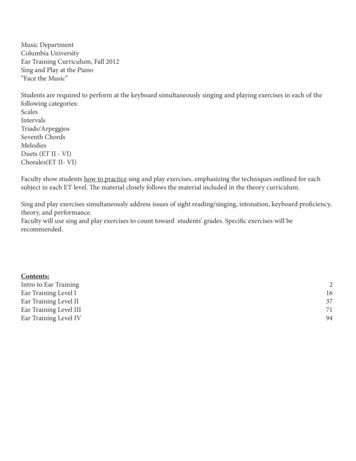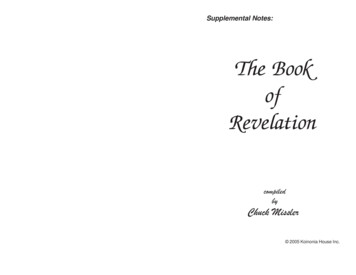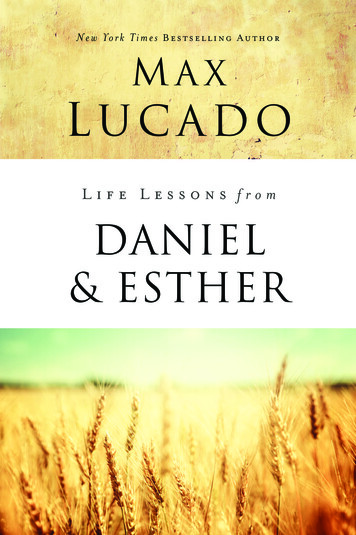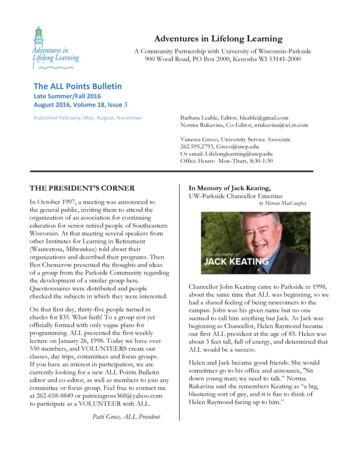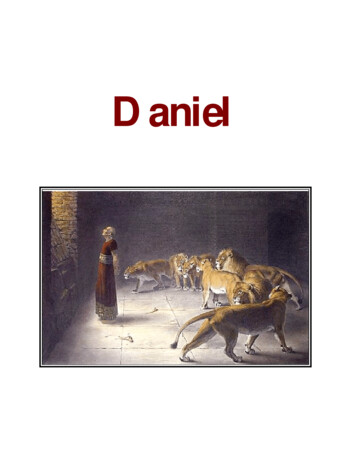
Transcription
years. With insight and clarity, Danylak has presented profound, biblical, andtheological truth that can revolutionize the church’s understanding and affirmation of singleness. This book is a gift to God’s people, and the impact could benothing less than incredible.”STEVE BROWN, EmeritusProfessor of Preaching, Reformed Theological Seminary; radiobroadcaster, Key Life Network“Barry Danylak’s work has been a great help to me in understanding the distinctiverole of singleness in God’s new-covenant people. There is much that the church asa whole, and not just single people, can learn from this.”LYDIA JAEGER,Academic Dean, Institut Biblique de Nogent-sur-Marne“Far from being a book just for single people, Redeeming Singleness demonstrateshow marriage and the single life give a complementary witness to the gospel inthe modern world. This is a hugely important and timely book for all Christians.”DANIEL KEATING, Associate Professor of Theology, Sacred Heart Major Seminary“Immensely helpful! Amidst extremes of celibacy versus marriage in Christianredeeming singleness“Finally! I’ve been hoping and praying for a book like Redeeming Singleness fortraditions on the one hand, and today’s proliferation of sexual non-commitmenton the other, Danylak gives us a thorough-going biblical theology of singleness.”J. SCOTT HORRELL,Professor of Theological Studies, Dallas Theological Seminarygraduate degrees in mathematics, Christian thought, and biblical exegesis, and isthe author of several reviews and articles. He has a passion for ministry to singleadults and regularly speaks and teaches on biblical singleness.DanylakBarry Danylak, a PhD candidate at the University of Cambridge, holdsBarry DanylakredeemingsinglenessHow the storyline of Scripture affirms the single lifeF O R E W O R D BY J O H N P I P E R
Redeeming Singleness: How the Storyline of Scripture Affirms the Single LifeCopyright 2010 by Barry Nicholas DanylakPublished by Crossway1300 Crescent StreetWheaton, Illinois 60187All rights reserved. No part of this publication may be reproduced, stored in a retrieval system, ortransmitted in any form by any means, electronic, mechanical, photocopy, recording, or otherwise,without the prior permission of the publisher, except as provided for by USA copyright law.Cover design: Amy BristowCover photo: Getty ImagesFirst printing 2010Printed in the United States of AmericaUnless otherwise indicated, Scripture quotations are from the ESV Bible (The Holy Bible, EnglishStandard Version ), copyright 2001 by Crossway. Used by permission. All rights reserved.Scripture quotations marked AT are the author’s translation.Scripture quotations marked NASB are from The New American Standard Bible . Copyright The Lockman Foundation 1960, 1962, 1963, 1968, 1971, 1972, 1973, 1975, 1977, 1995.Used by permission.Scripture quotations marked NET are from The NET Bible copyright 2003 by Biblical StudiesPress, L.L.C. www.netbible.com. All rights reserved. Quoted by permission.Scripture references marked NIV are taken from the Holy Bible, New International Version .Copyright 1973, 1978, 1984 Biblica. Used by permission of Zondervan. All rights reserved.The “NIV” and “New International Version” trademarks are registered in the United States Patentand Trademark Office by Biblica. Use of either trademark requires the permission of Biblica.Scripture references marked NLT are from The Holy Bible, New Living Translation, copyright 1996,2004. Used by permission of Tyndale House Publishers, Inc., Wheaton, Ill., 60189. All rightsreserved.Scripture references marked RSV are from The Revised Standard Version. Copyright 1946, 1952,1971, 1973 by the Division of Christian Education of the National Council of the Churches ofChrist in the U.S.A.All emphases in Scripture quotations have been added by the author.Trade paperback ISBN: 978-1-4335-0588-1PDF ISBN: 978-1-4335-0589-8Mobipocket ISBN: 978-1-4335-0590-4ePub ISBN: 978-1-4335-2286-4Library of Congress Cataloging-in-Publication Data'DQ\ODN %DUU\ 5HGHHPLQJ VLQJOHQHVV KRZ WKH VWRU\OLQH RI 6FULSWXUH DIILUPV WKH VLQJOH OLIH %DUU\ 'DQ\ODN IRUHZRUG E\ -RKQ 3LSHU S FP ,QFOXGHV ELEOLRJUDSKLFDO UHIHUHQFHV DQG LQGH[ ,6%1 WSE &HOLEDF\²%LEOLFDO WHDFKLQJ 6LQJOH SHRSOH²5HOLJLRXV OLIH²%LEOLFDO WHDFKLQJ , 7LWOH %6 6 ' ²GF &URVVZD\ LV D SXEOLVKLQJ PLQLVWU\ RI *RRG 1HZV 3XEOLVKHUV VP14131912181117105HGHHPLQJ6LQJOHQHVV L LQGG 16915871461351241132101 0
ContentsList of Abbreviations9List of Figures and Tables11Foreword by John Piper13Introduction151 Begetting from the Beginning:25Procreation, Marriage, and the Blessing of God to the World2 Living in the Land:55Why Every Israelite Man and Woman Married3 Prophetic Paradox:83How Failure of a Nation Brings Blessing to the World4 Good News for the Gentiles:115How Abraham’s Offspring Come from Jesus Alone5 The King and the Kingdom:143Jesus’ Surprising Statements on Singleness and Family6 A Charisma in Corinth:173Paul’s Vision of Singleness for the ChurchEpilogue213Bibliography217Notes225Subject Index245Scripture Index2485HGHHPLQJ6LQJOHQHVV L LQGG 0
5HGHHPLQJ6LQJOHQHVV L LQGG 0
Forewordby John PiperThe greatest, wisest, most fully human person who has ever lived nevermarried—Jesus Christ. His greatest apostle never married and was thankful for his singleness. Jesus himself said that in the age to come we donot marry. And he added that the age to come had already broken intothis world.Therefore, the presence of single people in the church not only“attests the sufficiency of Christ for the reception of God’s covenantalblessings in the new covenant,” as Danylak has written, but also remindsus “that the spiritual age has already been inaugurated in Christ andawaits imminent consummation.”When I met Barry Danylak at Tyndale House in Cambridge, England,in the summer of 2006, I was amazed at the research he was doing ona biblical theology of singleness. Not only was the scope of it unprecedented, but the theological and practical insights struck me as biblicallycompelling and practically urgent. I don’t know of anyone else who hasever provided the extent of biblical reflection on singleness that Barry hasprovided for us here.Both marriage and singleness demand the most serious and solidbiblical insight. These are realities that affect every area of our life andthought. We cannot settle for superficial pep talks. Our lives cry out forsignificance, and significance comes from seeing ourselves the way Godsees us—including our singleness. My guess is that virtually every singlewho reads this book will finish with a sense of wonder at who they areand how little they knew about this gift and calling.Barry is keenly aware of the progress of redemptive history and itsstunning implications for the single life. Early in that history, marriageand physical children were fundamental to the blessings of the Mosaiccovenant, but they are not fundamental to the new covenant the way135HGHHPLQJ6LQJOHQHVV L LQGG 0
Forewordthey were then. And what is beautiful about the way Barry develops thishistorical flow is that the glory of Jesus Christ is exalted above all things.Barry elevates but does not absolutize the calling of the single life. Itsgreatness lies, he says, in this: “It is a visible reminder that the kingdomof God points to a reality which stands beyond worldly preoccupationsof marriage, family, and career.” Indeed. And that greater reality is the allsatisfying, everlasting friendship of Jesus himself in the new heavens andthe new earth. Marriage and singleness will be transcended, and Christhimself will make those categories obsolete in the joy of his presence. Alife of joyful singleness witnesses to this.—John PiperPastor for Preaching and VisionBethlehem Baptist Church145HGHHPLQJ6LQJOHQHVV L LQGG 0
1Begetting from the BeginningProcreation, Marriage, and theBlessing of God to the WorldWhen I have occasion to speak before various church groups on questions of singleness and marriage, I often begin the discussion by asking,“Can anyone tell me what is the first commandment in the Bible?” Aftersome momentary blank stares, generally one or two individuals are braveenough to assert themselves and faithfully quote Matthew 22:37, “Youshall love the Lord your God with all your heart and with all your souland with all your mind.”“Ah, yes,” I respond, “you have faithfully cited the first and greatestcommandment. But I actually only asked for the first commandment inthe Bible, as in the first one we would find if we began reading it frompage 1.”At this point I encounter more quizzical stares. After all, mostChristians do not pay much attention to the order of biblical commandments, and even when we do, we struggle to agree on what constitutes abona fide command.If I were addressing a circle of Orthodox Jews, my audience wouldprobably not have been tricked by the question. They would likely haveknown of the work of the twelfth-century Jewish sage Maimonides, whocodified all 613 commandments of the Torah. The first of these 613 toappear chronologically in the Old Testament is the commandment, “Befruitful and multiply,” in Genesis 1:28.Once the answer is given, it seems painfully obvious. So I press theaudience with a further question: “And to whom was this commandment255HGHHPLQJ6LQJOHQHVV L LQGG 0
Redeeming Singlenessfirst given?” If there is silence a second time, it is because the questionappears too obvious to answer. Once again the question is a bit of atrick, because the commission to “be fruitful and multiply” is first givenin Genesis 1:22 on the fifth day of creation, to the sea creatures and thebirds, when God says, “Be fruitful and multiply and fill the waters in theseas, and let birds multiply on the earth.” The mandate is given again byGod to human beings on the sixth day: “Be fruitful and multiply and fillthe earth and subdue it and have dominion over the fish of the sea andover the birds of the heavens and over every living thing that moves onthe earth” (Gen. 1:28).In the Beginning . . .The First CommandmentReflecting upon this double occurrence in Genesis 1 of the mandate,“Be fruitful and multiply,” is instructive. It underscores that reproducingoneself is a fundamental and natural task, commissioned by God notonly for human beings but for the whole created order. The procreativemandate is given even before human beings are created. It is woven intothe very fabric of the created order that God fashioned before humanbeings were on the earth. What differentiates human beings from therest of the animal kingdom is not found in the reproductive commissionbut in the distinctive that they were created in the image of God and havean additional mandate to subdue the earth and have dominion over it.Jewish tradition, from the rabbinic interpreters of the New Testamentera onward, has not questioned interpreting “be fruitful and multiply” asa divine command of the Torah. The Jewish Mishnah makes it explicit:“No man may abstain from keeping the law, ‘Be fruitful and multiply,’unless he already has children.”1 The rabbis were explicit that the dutyof procreation falls on the man and not the woman.Some of my Protestant friends, on the other hand, have questionedthe presumption that “mandate” need be understood as a commandmentat all. Is it not rather a divine blessing? Genesis 1:28 makes the association between begetting and blessing explicit:God blessed them. And God said to them, “Be fruitful and multiplyand fill the earth and subdue it and have dominion over the fish of the265HGHHPLQJ6LQJOHQHVV L LQGG 0
Begetting from the Beginningsea and over the birds of the heavens and over every living thing thatmoves on the earth.”The imperative to “be fruitful and multiply” expected of the first humanbeings goes hand-in-hand with the act of God’s blessing them. Procreationrequires that a human act be carried out, but the results of the human actare efficacious only through divine provision. We already have perhaps ahint of the forthcoming drama found later in Genesis where the offspringof the covenantal blessing arises not simply through the human procreative act but as a result of God’s supernatural act of provision.While the act of being fruitful and multiplying is thus a divinehuman act, in actuality the Hebrew author sometimes stresses one aspectmore than the other. By examining whether blessing is mentioned inthe immediate context of the reference, and by looking at the subjectand form of the verb, we can get a relatively good sense of where thedominant emphasis is being applied. Table 1.1 provides a list of all theoccurrences of the couplet in the Old Testament (it never appears at allin the New Testament). Of the twelve Old Testament references to beingfruitful and multiplying, only five are clear imperatives upon humansor creatures (bolded in the table). It is given as an imperative to humanbeings only in three instances: to the first human beings, Adam and Eve;to Noah and his family; and to Jacob. At first it might seem surprisingthat it was given to Jacob and not also to Abraham, Isaac, Jacob’s sons,or Israel as a nation. But it does make some sense when we consider thatAdam was the progenitor of the human race, Noah was a second Adam,and Jacob was the immediate progenitor of the nation of Israel.2 Each ofthe three was father to a human race of critical importance.From the table it seems surprising that the mandate is given twiceto Noah, and in the second instance it is issued without the blessing.However, as Genesis 9:1–7 forms a single text unit, the command, asgiven in verse 7, may be nothing more than an emphatic reiteration ofverse 1. Maimonides cites Genesis 1:28, 9:1, and 9:6–7 as proof-texts forincluding “be fruitful and multiply” among the commandments of theTorah.3 Whether Maimonides was correct to include it among the divinecommands for all human beings is debatable. What we can concludefrom the creation account is that procreation is part of the pattern of the275HGHHPLQJ6LQJOHQHVV L LQGG 0
Redeeming Singlenesscreated order, it is associated with God’s blessing, and it was an explicitdivine commandment given to Adam, Noah, and Jacob.Table 1.1: Occurrences of “Be Fruitful and Multiply”in the Old TestamentTextReferentGod’s BlessingStated inContext?Subject ofVerbVerb FormEmphasizedActionGen. 1:22sea creaturesand birdsyesSea creaturesand birdsimperativepluraldivine andanimalGen. 1:28the firsthumans (Adamand Eve)yesthe firsthumans (Adamand Eve)imperativepluraldivine andhumanGen. 8:17animalsnoanimalsindicative-pluralanimalGen. 9:1NoahyesNoahimperativepluraldivine andhumanGen. 9:7NoahnoNoahimperativepluralhumanGen. ineGen. Gen. 35:11JacobyesJacobimperativesingulardivine andhumanGen. Lev. Jer. 23:3remnantnoremnantindicative-pluralhumanEzek. 36:11post-exilic IsraelnoGod and Israelindicative-pluraldivine andhumanThe Provision of MarriageWhile marriage is not explicitly mentioned early in the creation account,it is certainly implied in the concluding clauses of Genesis 1:27: “In theimage of God he created him; male and female he created them.” The biblical etiology (an account of something’s origin) of marriage as a divinelysanctioned human institution does not appear until the final scene of thecreation account in Genesis 2:18–24. In this latter episode we find nomention at all of procreation as the basis for marriage; rather, here themotivation for the account is the initial observation by the Lord God that285HGHHPLQJ6LQJOHQHVV L LQGG 0
Begetting from the Beginning“it is not good that the man should be alone; I will make him a helper fitfor him” (Gen. 2:18).With this initial pronouncement God puts Adam to sleep, takeshis rib from him, and creates Eve. The didactic function of the episodeis made clear in the concluding pronouncement in 2:24: “Therefore aman shall leave his father and his mother and hold fast to his wife, andthey shall become one flesh.” So while an implied purpose for marriagein the creation account is to enable fulfillment of the divine mandate to“be fruitful and multiply,” the explicit purpose the account gives is forcompanionship and assistance.Here we see emerging a seminal theology of marriage. The wifeserves both as relational companion and as provider of material assistanceto the husband. The husband in turn functions in a complementary rolefor the wife. The separation of the two incidents perhaps serves to highlight the author’s point that marriage was intended to provide more thanthe mere need to procreate legitimate heirs; it was also the foundation ofthe new institution of relational support in the human family unit.In Jesus’ discussion with the Pharisees about divorce, he cites asthe basis for marriage Genesis 1:27, “male and female he created them,”which he conjoins with the conclusion in 2:24, “Therefore a man shallleave his father and his mother and hold fast to his wife, and they shallbecome one flesh.”4 In the context of Genesis 2, the “therefore” of verse24 follows from the man’s condition of first being alone (v. 18) andsubsequently receiving the woman as “flesh of my flesh” (v. 23). Jesus,however, links the conclusion not to the man’s need for companionshipbut rather to God’s ordained pattern of creation as constituting them“male and female.”Maimonides also lists “taking a wife” through contractual arrangement among his 613 commandments of the Torah but cites a casuisticlegal precept in Deuteronomy 22:13–15 rather than Genesis 2 as thebasis of the commandment.5 Maimonides’ understanding of marriageas a commandment of the Torah would have resonated with the earlierrabbinic tradition, which presumed marriage to be a requirement as themeans to fulfill one’s lifelong procreative duty to “be fruitful and multiply,” illustrated well in the second-century rabbinic tractate Abot R.Nathan:295HGHHPLQJ6LQJOHQHVV L LQGG 0
Redeeming SinglenessMarry a wife when you are young, and marry a wife when you are old,beget children when you are young, and beget children when you areold. Do not say, “I shall not get married,” but get married and producesons and daughters and so increase procreation in the world. “For youdo not know which will prosper, the one or the other, or perhaps both ofthem will survive, and they shall both turn out well. In the morning sowyour seed and in the evening keep it up” (Eccles. 11:6).6The presumed close tie between marriage and procreation was acommon concept in the ancient world. Prescribing them as codifiedlegal mandates was also common, beyond mere Jewish interpretations ofthe Old Testament. The idea of state-instituted laws requiring marriagewas also common amongst Greco-Roman political theorists. In Plato’slater discussion of political theory, given in his Laws, for example, herecognizes that the foundational building block of any political state liesin the partnership of marriage. Thus, it follows that the state’s first legalenactment should be the institution of laws requiring a man to marry.7Plato was not alone, for, as we shall see later, similar ideas were commonto other ancient writers.In exploring the close connection between marriage and procreationin the ancient world, we begin to see clearly the distinctive view of marriage given in the Genesis account. First, we are struck by the immediateprominence of God’s blessing on the whole created order through procreation. Marriage is acknowledged implicitly from the very beginningin God’s creation of humans as male and female. Marriage thus providesthe means to accomplish God’s initial blessed mandate to human beingsto “be fruitful and multiply.” But in providing a secondary account of theinstitution of marriage at the end of the creation story, the biblical authoremphasizes that marriage has been ordained by God to be more than justa provision for procreation; it is also the means for companionship andsupport through a couple’s unity in forming a new family unit.Offspring and the FallHaving already seen the prominence of procreation within the creationaccount, it is not surprising to find that offspring emerges as a recurring theological motif through the development of biblical history. The305HGHHPLQJ6LQJOHQHVV L LQGG 0
Begetting from the BeginningHebrew term used for offspring is the word zera’, which can be translatedinto English as “offspring” or “seed” or other words, depending on thecontext. Just as the English word seed can refer botanically to the seedsown by a farmer, the semen of a male animal, a single physical offspringof a human or animal, or the aggregate descendants of a human being, sotoo a similar range of usage applies in the Hebrew. Although the onceubiquitous King James Version nearly always translated zera’ as “seed,”modern translations tend to translate the term into a range of contextually specific English equivalents such as “seed,” “semen,” “offspring,”“children,” “lineage,” or “descendants.”Even before the narrative moves out of Eden, we encounter theimportance of offspring in the account of the fall. The text of Genesis 3portrays three separate culpable agents. The Serpent deceived Eve witha lie. Eve listened to the Serpent, disobeying God. Adam listened to Eve,disobeying God. In God’s pronouncement of judgment upon the Serpent,two references to offspring occur:I will put enmity between you and the woman, and between youroffspring and her offspring; he shall bruise your head, and you shallbruise his heel. (Gen. 3:15)The judgment upon the Serpent is that there will be constant enmitybetween his offspring and the woman’s offspring. At one level, we couldhave here a biblical etiology of why snakes bite men, and why men try tokill snakes. But as Gordon Wenham points out, this is a judgment againstthe Serpent, not the woman.8 The serpent is at a tactical disadvantage.Moreover, a wound to the head is more likely to be fatal than a wound tothe heel. Likewise, a personified speaking serpent in the account suggeststhat it represents more than a suborder of reptiles but rather the personified power of evil hostile to the plans and purposes of God.In short, the enmity between two sets of offspring points to the futurecontinued struggle between human beings (the offspring of the woman)and the personified forces of evil in Satan and his cohorts. Whereas theforces of evil will inflict harm upon the offspring of Eve, the offspring ofEve will eventually fatally crush the forces of evil.Patristic authors from Justin and Irenaeus onward have regarded315HGHHPLQJ6LQJOHQHVV L LQGG 0
Redeeming SinglenessGenesis 3:15 as the protoevangelium, the first Old Testament prophecyof Christ.9 The patristic authors employ the ambiguity between the collective offspring and a singular offspring in making the assertion. Paultells the Roman church, “The God of peace will soon crush Satan underyour feet” (Rom. 16:20). If this is an allusion to Genesis 3:15, it suggestsan image of God crushing Satan through his people, i.e., the church. Soperhaps there is a sense in which both a particular and an aggregate senseof seed are simultaneously in view.Another OffspringThe next reference to offspring in Genesis occurs in Genesis 4:25 as partof Eve’s response when she bears her third son, Seth. The dominantstoryline of Genesis 4 concerns the contrast between Abel’s acceptablesacrifice and Cain’s unacceptable sacrifice, Cain’s accountability beforeGod for his subsequent murder of Abel, and the portrayal of how Cain’sviolent disposition is subsequently passed down through his progeny, asrepresented by the figure of Lamech. From the foundation of human history we can observe two distinct lines of progeny coming from Adam andEve—one represented by Cain marked by violence, which was eventuallydestroyed in the flood, and the other represented by Abel and Seth, whichwas marked by obedience, sacrificial death, and new life.While the traditional contrast of the chapter is between Cain andAbel with Seth only mentioned in the concluding two verses, when welook at the description of the birth accounts it is Cain and Seth that formthe interesting parallel, while there is only passing mention of the birthof Abel. The births are described as follows:. . . and she conceived and bore Cain, saying, “I have gotten a man withthe help of the LORD.” (Gen. 4:1). . . and she bore a son and called his name Seth, for she said, “Godhas appointed for me another offspring instead of Abel, for Cain killedhim.” (Gen. 4:25)In each case Eve bears a son, names him, and makes a declaration to theLord commemorating the occasion; but in two instances the subject,verb, and object are different. In the first instance the act of producing a325HGHHPLQJ6LQJOHQHVV L LQGG 0
Begetting from the Beginningchild is Eve’s. Eve “gets” for herself a “man” with the “help” of the Lord.To commemorate her act, she names her son Cain, meaning “possession,”a wordplay on the Hebrew verb qanah meaning “get.”In the second instance God is the subject and Eve is the indirectobject. This time Eve acknowledges that God appointed another offspring. She names this son Seth, meaning “substitute,” which is also anapparent wordplay on the Hebrew verb shith for “placing” or “appointing.” The contrast in the type of birth is expressed in the names of Eve’ssons. Cain is the result of Eve’s own act of getting a man, whereas Seth isGod’s provision of an appointed offspring. In her effort, Eve bears sinfulprogeny of violence and ultimate death. But God provides through heranother offspring that ultimately brings life and hope.The theme of offspring as a special provision of God is a recurringone throughout the book of Genesis. It is a theme that reinforces a fundamental difference between the God of the Old Testament and fertilitydeities popular among Israel’s ancient Near Eastern neighbors.10 Unlikethe gods of other Semitic traditions, the God of Israel has no femaleconsort and is not worshiped by means of cultic prostitution. Mostimportantly, the God of Israel is not manipulated by human beings as inthe case of other fertility-oriented religions, where, through the worshipand sacrifices of human beings, the gods were stimulated to replenish theearth. But from the first generation of humankind, Genesis emphasizesby contrast that it is God alone who provides the appointed offspring.The vocabulary distinction between Eve’s bearing Cain as a “man”and God’s providing Seth as “another offspring” also hints that, as inGenesis 3:15, messianic implications are in view. These messianicovertones in the provision of Seth were recognized within the Jewishinterpretive tradition even prior to the New Testament era.11 In the bookof Jubilees, for example, it is Adam rather than Eve that names Seth andcomments on his birth:He [Adam] named him Seth because he said, “The LORD has raisedup another seed for us upon the earth in place of Abel because Cainkilled him.” (Jub. 4:7)12At least three changes in vocabulary underscore that messianic335HGHHPLQJ6LQJOHQHVV L LQGG 0
Redeeming Singlenessovertones are in view. The child is not merely provided by the Lord buthe is one “raised up” by the Lord. He is a child provided by God notjust to Eve but “for us,” with Adam rather than Eve as prominent. Thechild is placed by the Lord “upon the earth,” ostensibly to complete amission.The other messianic hint is in the term “another offspring” or“another seed.” As in English the Hebrew word for “another” (’akher) usedhere can connote the sense of “subsequent” or “following,” but it can alsocarry the nuance of “other” or “different” (e.g., Lev. 27:20; Ps. 109:8). Alater Jewish midrashic commentary thus concluded:And what was that “other child” [that would arise from another sourceto which she made reference]? It was the king-messiah.13Though the Jewish interpreters could see that the modifier “another”might imply something more significant than simply that God provideda “subsequent” offspring, the particular nature of the different offspringprovided by God is here unspecified. The full nature of that special character is to be fully revealed only in the course of the developing storylineof the biblical text.Abraham and His OffspringWe turn next to the substance and content of God’s covenant blessingto Abraham. Whereas the history of the human race begins with Adam,the history of God’s chosen people begins with the figure of Abraham.Abraham is thus a pivotal figure in the whole of biblical history and theology. The central drama of the book of Genesis is the narrative accountof God establishing his covenant with Abraham and confirming it withhis descendants. God’s covenant with Abraham is a unilateral promissory covenant—a commitment of how God will bless Abraham and hisdescendants. And, not surprisingly, the provision of offspring featuresprominently both in the narrative drama of the story of Abraham and inthe substance of the covenantal promises. To see this effectively and toexplore the implications requires a careful examination of the substanceof covenantal promises that God gives to Abraham as they unfold in thenarrative. This occurs not on a single occasion but through a series of345HGHHPLQJ6LQJOHQHVV L LQGG 0
Begetting from the Beginningepisodes during the course of his sojourn in Canaan as God developsand tests his faith.Abraham’s Call: Genesis 12:1–9The accoun
FOREWORD BY JOHN PIPER redeeming sing leness re d eeming sing l eness Danylak ÒFinally! IÕve been hoping and praying for a book like Redeeming Singleness for years. With insight and clarity, Danylak has presented profound, biblical, and theological truth that can revolutionize the churchÕs understanding and a!rma - tion of singleness.
